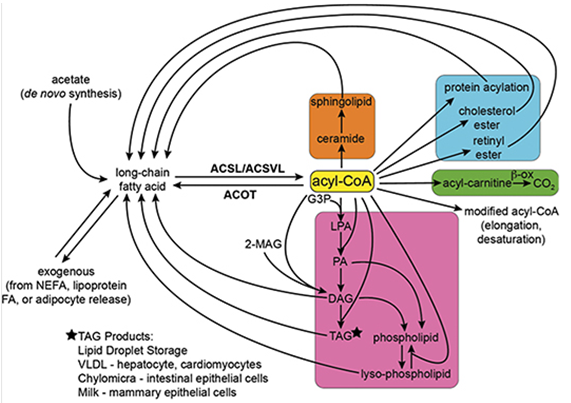Acyl-CoA Analysis
Acyl-CoA is a family of coenzymes involved in fatty acid metabolism, formed when CoA attaches to the end of long-chain fatty acids in living cells. Acyl-CoA undergoes β-oxidation to form at least one acetyl-CoA molecule, which enters the citric acid cycle to ultimately produce ATP molecules.
When energy demand increases, such as during illness, fasting, and muscle exercise, the oxidation of fatty acids in mitochondria produces energy for use. The biological process of fatty acid oxidation (FAO) includes the carnitine cycle, β-oxidation cycle, electron transport chain, and ketogenesis in the liver. Free fatty acids are activated to CoA esters in the cytosol outside the mitochondrial membrane. Long-chain (C16 and C18) acyl-CoA enters mitochondria as acyl-carnitine and is converted back to the corresponding acyl-CoA on the mitochondrial membrane.
During the process of fatty acid oxidation, the acyl-CoA chain is shortened by two carbon atoms until it is completely converted into acetyl-CoA. The energy released during β-oxidation is transferred to the electron transport chain to generate adenosine triphosphate (ATP). In the liver, most acetyl-CoA is used to synthesize ketone bodies (3-hydroxybutyrate and acetoacetate), which can be used as fuel by tissues that cannot oxidize fatty acids (especially the brain). Fatty acids can be directly used as an energy source by tissues such as the heart and skeletal muscles. Diseases of fatty acid oxidation can lead to various phenotypes, including brain damage, hypoglycemia, renal dysfunction, liver disease, and heart and skeletal muscle damage.

Acyl-CoA analysis
Early detection of fatty acid oxidation is important for early assessment and prevention of diseases. The main accumulated metabolites in fatty acid oxidation defects are acyl-CoA within the mitochondria. Typically, these defects can be studied by measuring secondary metabolites such as acyl-carnitine, acyl-glycine, and dicarboxylic acids. Most separation methods involve HPLC separation, and due to hydrophobicity differences between long-chain, medium-chain, and short-chain acyl-CoA, complete detection of acyl-CoA is difficult to achieve. Andrew A. Palladino achieved direct measurement of different acyl-CoA of all chain lengths using flow injection tandem mass spectrometry, a method evaluated and tested on liver tissue of mice with short-chain acyl-CoA dehydrogenase deficiency and mice with knockout genes for medium-chain and short-chain 3-hydroxyacyl-CoA dehydrogenase.
Biotage offers reliable, fast, and cost-effective acyl-CoA analysis services based on a highly stable, reproducible, and sensitive system for separation, characterization, identification, and quantification, combined with LC-MS/MS.
Biotage offers the following acyl-CoA analyses
1. Palmitoyl-CoA
2. Palmitoleoyl-CoA
3. Stearoyl-CoA
4. Oleoyl-CoA
5. Linoleoyl-CoA
6. Arachidyl-CoA
7. Arachidonyl-CoA
8. Behenyl-CoA
9. Lignoceryl-CoA (Tetracosahexaenoyl)
10. Cerotyl-CoA
Related services
Targeted lipidomics
Untargeted lipidomics
Lipid metabolism studies
Targeted metabolomics
Acetyl-CoA
Carnitine and acyl-carnitines
How to order?





